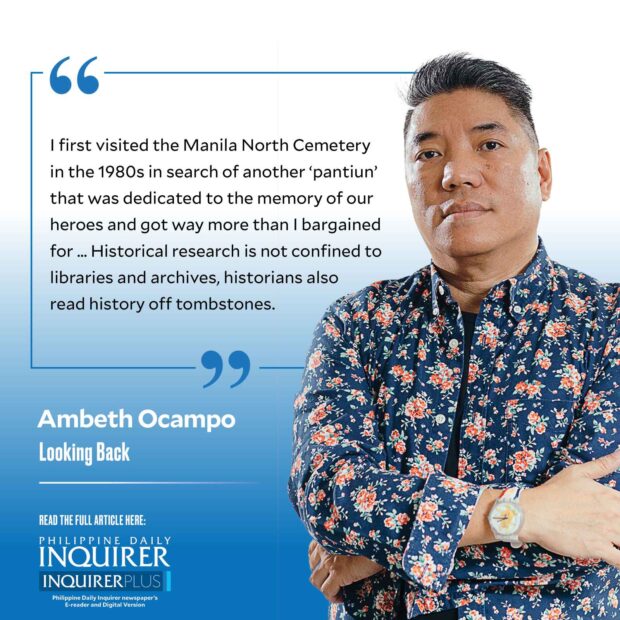History from tombstones

Growing up, Nov. 1 always started off with a morning visit to the maternal grandmother I never knew. She was buried on the side of Taguig church, dedicated to Santa Ana, which was built in the 19th century, over the site of others dating way back to the 16th century. My mother’s father lived in Pasay so we knew him as “Lolo Pasay” while the little old lady I knew as “Lola Pasay” was my maternal grandfather’s second wife. My paternal grandparents lived in San Fernando and were not called “Lolo and Lola Pampanga” but “Ingkong” and “Apu.” I had more fun and better food in my father’s hometown, Minalin, rather than Taguig.
Childhood memories are of exploring the crowded cemetery in search of candle wax drippings gathered to form round lumps the size and shape of a baseball. We mistranslated the Spanish “cementerio” into English as “cemetery,” while the adults referred to it as “campo santo” or “pantiun.” Years later, I was to learn that “pantiun” was not Kapampangan but from the Greek “pantheon,” a temple dedicated to all the ancient gods from Apollo to Zeus.
I first visited the Manila North Cemetery in the 1980s in search of another “pantiun” that was dedicated to the memory of our heroes and got way more than I bargained for. Manila’s necropolis dates back to the 19th century and is the sum of three parts: Manila North Cemetery, also known under its Spanish name Cementerio del Norte de Manila, the Chinese cemetery, and La Loma that borders Manila and Caloocan. Although I have only explored the lechon stalls of La Loma, I am told that it is home to just as many historical figures as Manila North.
Article continues after this advertisementE. Arsenio Manuel, author of the four-volume “Dictionary of Philippine Biography” (1955-1995) taught me that it was important to gather biographical data from tombstones. When I got to Manila North, I was sidetracked by the wide range of architectural styles used on mausoleums and graves. One mausoleum has the elements of a Gothic-style church, some are in Art Deco while others are whimsical. My all-time favorites are the grave of “Admiral” Tomas Cloma, in the form of a ship named S.S. Last Voyage, and the Tuason-Legarda mausoleum which is a white-washed pyramid guarded by concrete sphinxes.
By the entrance to the cemetery is a plot dedicated to the Filipino Boy Scouts who died in a plane crash en route to the 1963 World Jamboree in Greece. I read every tombstone to catch the first names left out of the street names that cut through Tomas Morato in Quezon City like Scout Delgado, Scout de Guia, Scout Fuentebella, etc. Another plot is dedicated to the American teachers who arrived on our shores in the early 20th century aboard United States transport, the first being the S.S. Sheridan followed by the S.S. Thomas whose passengers were known as the “Thomasites.” Within Norte, one will find a Masonic cemetery, another for the Armed Forces, and yet another set aside for Jews. The Jewish Cemetery is fenced in, with graves marked by the six-pointed Star of David rather than the usual Christian cross. My favorite is the one marked by fire hydrants and a wonderful pillar with a coiled water hose leading up to a uniformed American fireman.
Philippine presidents Sergio Osmeña, Manuel Roxas, and Ramon Magsaysay are buried in Manila North Cemetery. Manuel Quezon and his wife Aurora used to be in Norte before their remains were moved to the heart of Quezon Memorial in the Quezon City elliptical circle. US governor general Francis Burton Harrison can be found here as well as mayors of Manila, the most prominent being three whose names begin with “A”: Arsenio Lacson, Antonio Villegas, and Alfredo S. Lim.
Article continues after this advertisementThe pantheon to heroes of the Philippine Revolution and the Philippine American War was commissioned by US governor general James Smith in 1908 and was formerly known as the “Mousuleo de los Veteranos de la Revolucion.” The structure designed by Arcadio Arellano must have been impressive when it was inaugurated in 1920, but 60 years later it was fenced in by other mausoleums. I was disappointed to find it nearly empty of heroes in the 1980s, a family had taken over and on my first visit, a baby was sleeping soundly in a crib while the mother was frying fish for lunch. Open, empty niches were filled with personal effects and cooking implements. Alas, I did not have a smartphone to document the shoes, pots, and pans in the niches. Names I recognized on the tombstones were of revolutionary generals: Fernando Canon, Adriano Hernández, Licerio Gerónimo, and Pio del Pilar. Other notable occupants have moved elsewhere, claimed by the local governments of their birthplace like Melchora Aquino aka “Tandang Sora” who changed residence from the Pantheon to Himlayang Pilipino Memorial Park in Quezon City.
Historical research is not confined to libraries and archives, historians also read history off tombstones.
—————-
Comments are welcome at aocampo@ateneo.edu
















